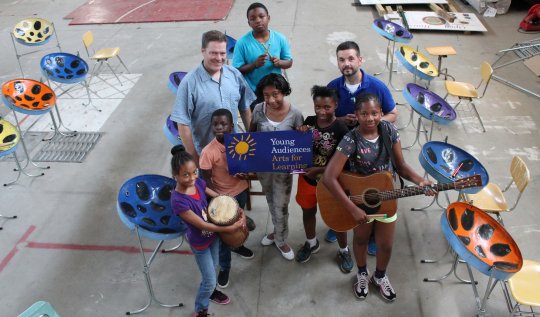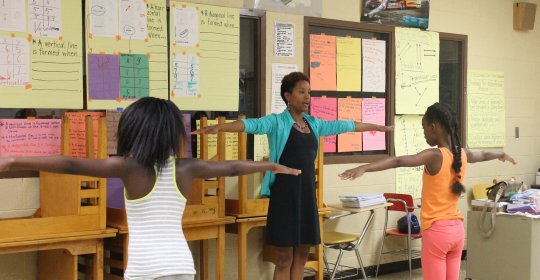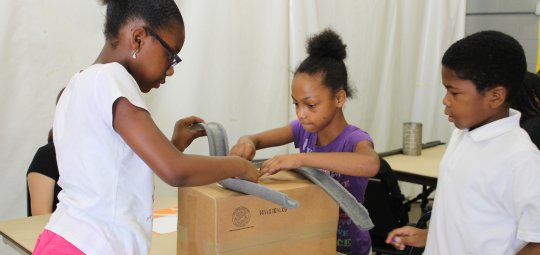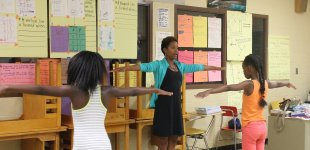
Without any intervention, all students lose an average of two months of learning during the summer, but for low-income students, the loss is even greater. For many at-risk students, summer is a time of uncertainty when the absence of a school schedule leaves children without adequate supervision, access to regular meals, and opportunities to participate in constructive learning.
This summer, Young Audiences addressed this uncertainty by operating the first arts-integrated Baltimore City Public Schools summer school. The free program ensured that 100 middle school students were engaged in hands-on learning and were ready to return to school in the fall confident in their abilities in math and science—all while having fun, thanks to arts integration. Students were at the center of this innovative project and every detail of the student experience was carefully thought out. Lessons gave students the opportunity to develop their knowledge through the arts, and exposure to a variety of art forms allowed them to learn about themselves as they took risks trying new things.
One of the biggest surprises of the program came through something that wasn’t planned—the impact on participating teachers, for whom the experience proved to be just as transformative as for the students they taught each day. Teachers and artists co-taught STEM-focused lessons and worked together to find natural connections between core subjects and the arts. This fall, our students returned to school ready to pick up where the previous year left off and to apply the new skills and knowledge they learned from teachers and artists this summer. Below is a response from Grace Galarpe, a Baltimore City School teacher, who partnered with us during the summer school program.
Kurtis Donnelly, Program Director
Young Audiences/Arts for Learning Maryland
Leaping Headfirst into Arts Integration
By Grace Galarpe, Baltimore City Public School teacher
When I got involved in the Young Audiences and Baltimore City Public Schools 22nd Century Pioneers Arts-Based Summer Camp, I wasn’t sure if I was in the right place at first. Even though I’ve seen arts integration in the news, this summer was my first time really working with it. It was my first time working with Young Audiences, too, so when they told me that this program was all about arts integration, I was curious to learn more.
As a high school teacher, I’ve had the opportunity to collaborate with other core subject teachers before, but a collaboration with an artist? This was my first time and the idea interested me. In the past, I’ve used the arts in my classroom in the sense that we would sometimes draw or dance or sing. If I did incorporate the arts, it was separate. These activities would be after instruction or after school. The program this summer, where arts integration happened within the instruction, used a completely different method.
I was paired with Valerie Branch, a dancer. Before Valerie and I started teaching, we did lesson planning. Looking back, we consider this the biggest factor in our success because the planning helped us gain a greater understanding of how we would integrate the arts into our lessons.

Young Audiences teaching artist Valerie Branch shows students the art of dance
I was very fortunate because both of us took the program very seriously. We would do thorough planning and would really talk about what was going to happen the next day and the next. Everything that Valerie and I accomplished this summer was possible because we had time to plan together. I wasn’t just going into a classroom where I would do everything by myself; it was a partnership.
Our lessons weren’t always perfect, but since the teacher and the artist planned together, we could always reflect and revise–not just one of us, but both of us. We helped and respected each other, and as the summer went by, we became very comfortable with one another. When Valerie and I would sit down together, she made me feel confident about where the arts would come in and how we would make it possible. She made me feel more comfortable with her art form, too, and because of this, I could easily explain the elements of dance to students.
This summer, I realized that a dance activity can be incorporated with a science activity using the same concepts and vocabulary. That was amazing to me. At first, I wondered, “How will my students benefit from this collaboration and integration of the arts?” I now feel that arts integration gives students the chance to learn at a different level because we are able to touch multiple intelligences. I believe that our students achieved a deeper understanding of the science concepts and vocabulary that we taught them due to the integration of the arts into our teaching. They were able to apply what they had learned, not only through science but through dance, too.
Sometimes during the science instruction, students would ask: “Why do we need to learn this?” I would respond that they needed to know the terms and concepts so that we could apply them to our next dance choreography, and then they would get excited. When Valerie would talk about the elements of dance at the same time as the science, the students would be able to perform a dance choreography based on something related to science, such as pollution. That was a really wonderful outcome.

After a visit to the Baltimore Museum of Industry, students put their own engineering skills to the test.
I can now see that if arts integration is a regular part of a classroom, it helps increase academic achievement and positive intervention regarding behavioral problems. I could tell that the arts were a huge help in attendance in our classroom, too, and I was so happy that the students looked forward to our class every day.
The arts also helped create responsibility. For example, Valerie and I decided that we needed to do something that would make the students understand that they had an obligation in the classroom. As a part of our teaching, we did an activity we called “Human Mirror,” which incorporates dance movements that develop a sense of responsibility. It requires listening, following directions correctly, being observant, and an understanding of what it means to be a leader and a follower. This was a great success for our class. I could sense that the students also gained respect for both of us. They called both me and Valerie artists, which surprised me. I was like, “Oh wow, I’m an artist!”
If ever given the chance, I would tell teachers who haven’t used arts integration not to be afraid of co-teaching with an artist. If there were an opportunity for me to be involved in another arts integration program, I would gladly do it. I’ve realized that in programs like this, the artist and teacher can become more than just teachers. I believe that they can do more than just share concepts or explain the academic side of things: they can inspire students’ lives.
Read more about the Young Audiences 22nd Century Pioneers Arts-Based Summer Camp site and see photos here. This blog feature was originally posted on the Young Audiences/Arts for Learning Maryland blog.


